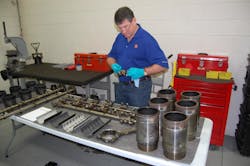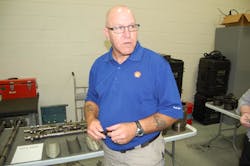GREENSBORO, NC. The need to develop new time-consuming and often expensive test regimens for PC-11 engine oils is slowing down the projected delivery timeline for the new oil, though not significantly or permanently at this point.
Dan Arcy, global OEM technical manager for Shell Global Solutions and also the industry trade association liaison for the PC-11 development effort, noted during a press event held here at the Greensboro facility of commercial vehicle maintenance provider Clarke Power Services that the need to add new tests, as well as modify existing ones, is creating some headwinds for the PC-11 program.
“You need to ensure that any test used to confirm PC-11 viability is standardized and repeatable,” he explained to Fleet Owner. “For example, one lab used a particular process that clearly delineated between ‘good’ and ‘bad’ PC-11 oil blends. But that same process used by a different lab did not produce such clear delineation. That requires time to sort out, to figure out what went wrong, so as a result we’re running a little behind in test development.”Arcy noted that if the PC-11 timeline is plotted out from the point it’s at right now, the oil would nominally be ready by September 2016 instead of its listed completion date of April 2016. “And April already represents a push back from the category’s original end point of January 2016, established when the PC-11 development process began in June 2011,” he said.
Other factors are also adding to the delays, including the need to incorporate new engine technology and metallurgy into the testing process, not to mention engine temperatures that are expected to rise by 18 degrees Fahrenheit by 2017 as a result of modifications to help maintain emission compliance while boosting fuel economy.
“And the last time we went through the development process for a new DEO [heavy duty engine oil] category was for CJ-4, which is almost 10 years ago,” Arcy said. “In the past we used to develop a new category every four years. Now with a 10-year gap many of the engine tests we used to use are no longer relevant.”
Putting together new tests for PC-11 is neither a cheap nor fast process, he stressed. “For example, take a Mack T-13 test, which requires 360 hours to fully complete,” Arcy noted. “If that test goes awry, basically you’ve lost two to three weeks of time.”The fuel required to conduct such tests makes them, costly as well, often running to $600,000 per test in some cases, added Howard Hill (seen at left), Shell’s HDEO field trial coordinator for North America.
Arcy also noted that only seven old CJ-4 tests are being carried over to PC-11, alongside the addition of three new tests and modifications several others.
Another wrinkle in the test development process is that two subcategories of PC-11 oil blends are being developed: PC-11 A, which will be a high temperature/high shear or HTHS oil, and PC-11 B, which is be a low HTHS or “thinner” oil – one that most likely won’t be backward compatible with pre-2017 model engines, though Arcy suspects that might be extended back to some 2014 models.
“Not only are we now looking at developing completely new tests, we’re changing existing tests to run them in a new way to look at different characteristics such as scuffing and lining wear,” he said. “New tolerances are also being added to some older tests as well.”
Yet Arcy also stressed that test modifications could also help speed up the PC-11 developmental program as well.
“Take the new scuffing and adhesion wear test we crafted using a 5010-hp DD13 engine. That test lasts 150 hours but originally took 800 to 900 hours to complete – nearly a month,” he said. “So we adjusted the severity of the test to get better more repeatable results in less time; we may even be able to shorten it to 125 hours. That could help us get us back on our original track.”
About the Author
Sean Kilcarr
Editor in Chief
Sean Kilcarr is a former longtime FleetOwner senior editor who wrote for the publication from 2000 to 2018. He served as editor-in-chief from 2017 to 2018.


